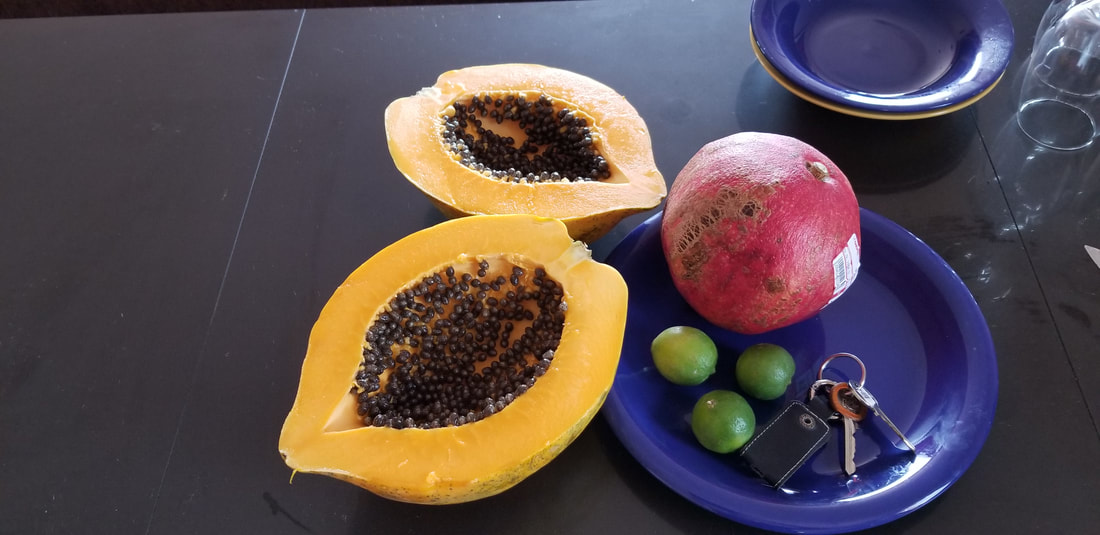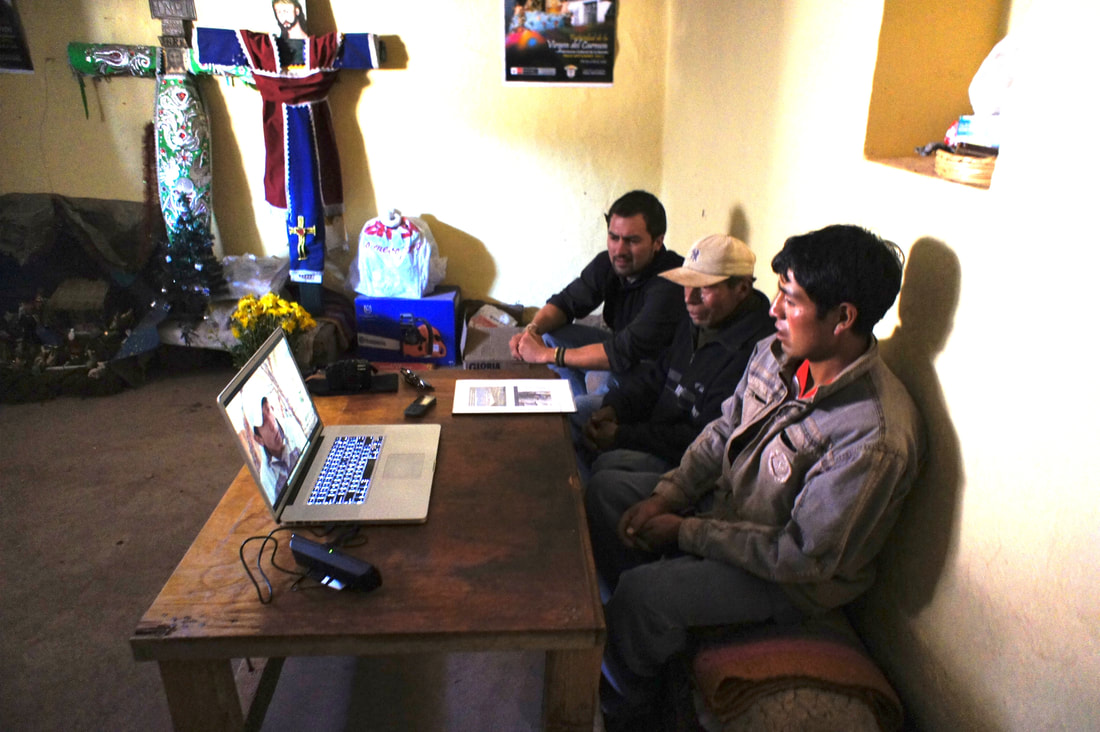 Our last visit in 2012 with the Ministry of Culture staff. L to R Samuel Kjuro Arenas, Jose Antonio Reynoso, Benjamin Younkman, Mario Cornejo & Maren Elwood Our last visit in 2012 with the Ministry of Culture staff. L to R Samuel Kjuro Arenas, Jose Antonio Reynoso, Benjamin Younkman, Mario Cornejo & Maren Elwood When I finally knew I was coming down to Saqsaywaman again to continue the work I started in 2010, there were some people who said to me "Wow, you are really going to go." I found this comment strange to me given I never had a doubt that I'd get back here at some point. I guess to some people my constant referral to this project and my desire to get back to continue the research seemed like a pipe dream. I certainly understand that outside perspective. But, when you have a dream; when you have a purpose in life; no matter what happens you believe in yourself. Having a vision is knowing you will get it done and turning over the "how it will get done" to the Universe. It's been so heart warming to reconnect with all these people again and most have moved up in the management structure at Saqsaywaman and Cusco in genera.
 The good news is that since I've been here last, the Ministry of Culture in Q'osqo has created a new centralized office that's in charge of all archaeological and anthropological work in and around. This new division of the Ministry of run by a rather famous Peruvian author and heritage professional Sr. Luis Nieto Degregori. We finally figured out yesterday that our research proposal, with the old Convenio needed to go to his office with a formal letter attached. And, it had to be stamped for us to proceed with initial conversations with the Saqsaywaman park officials. We got that letter "stamped" this morning at 7:20 am...then proceeded to Saqsaywaman for our second conversation with the park officials. Looks like now the paperwork will be finalized by early next week and we'll be on the site finally working! It's taken PERSEVERANCE and I couldn't have done this without Dalton Gaudin, who has believed in this project for years and today he held his own talking with the Saqsaywaman park director Francisco Solis Diaz.
 When Ben Younkman and I were here last, the amount of damage being done to the site by water was distressing. That has all been mediated at this point. The relationships with the communities has been improved largely due to the new style of the Director, but also by the additional of 4 park archaeologists who directly interface with the communities on a regular basis. There do remain conflicts between the Ministry and the communities, not least of which is that one community has actually tried to sell part of their land (right below where a circular pyramid is) to a Brazilian hotel chain. Just yesterday, the central office of the Ministry passed a resolution to ban this hotel company from building on the active archaeological zone We will be delving into this desire to sell the land once we get started with our research.  One of the exciting developments has been the possibility of this project being featured in the upcoming Association for Preservation Technology International conference in Miami in November 2019. This project is an almost perfect fit for one of their major tracks: Track 2: Sustainability and Conservation of Built Heritage in the Americas
 Mario & Maren are back on the mend and ready to start work on the site again next week. Mario & Maren are back on the mend and ready to start work on the site again next week. Finally, the health of team members has played a role on this project this time. One of our major contacts, Mario Cornejo Ortiz, spent 11 days in the hospital starting the day after our Pago ritual. He has been one of our major contacts and tended to steward paperwork through the process, so we were delayed for a bit as a result of that. And, I have had a pretty bad stomach bug. Finally on the mend, but being sick at this altitude is no fun. You need every bit of energy to deal with this geography. So, maybe it's better that we are not starting in earnest till next week. I don't think I would have been up to climbing into the communities last week. And, the good news is that Mario is back to work and feeling much better. Both of us have lost some extra weight.
0 Comments
 Miriam's blood oxygen levels went from high 60% to 70%...not the optimal 85% to 95% desired. Miriam's blood oxygen levels went from high 60% to 70%...not the optimal 85% to 95% desired. HEALTH FIRST I had hoped this next blog would be a more in-depth explanation of the history of the Pachamama ritual we did last week up at Saqsaywaman. But, given some unforeseen circumstances, this week's blog will be about the logistics of living at 11,200 miles above sea level (in Q'osqo - Saqsaywaman is at 12,143 miles above sea level) and the day-to-day challenges of living in another culture. High altitudes always cause people who spend most of their lives near the coast, or even a bit higher, headaches and dehydration are always to be planned for. But, this week, my good friend Miriam (who was my first adult expedition member) had a bit more of a challenge. Apparently, you need to sustain an oxygen level in your blood of at least 85% - 90%, but her's was dipping as low as the high 60%. So, Friday of last week, off to the hospital we went. The doctors here at the SOS Clinica, partners with Maximo Nivel, were great! But, bottom line, Miriam was in the hospital for 4 days and ultimately had to go home. Apparently, some people just can't adjust to this altitude. And, if you have any type of bronchial challenges, that makes it even harder to adjust. 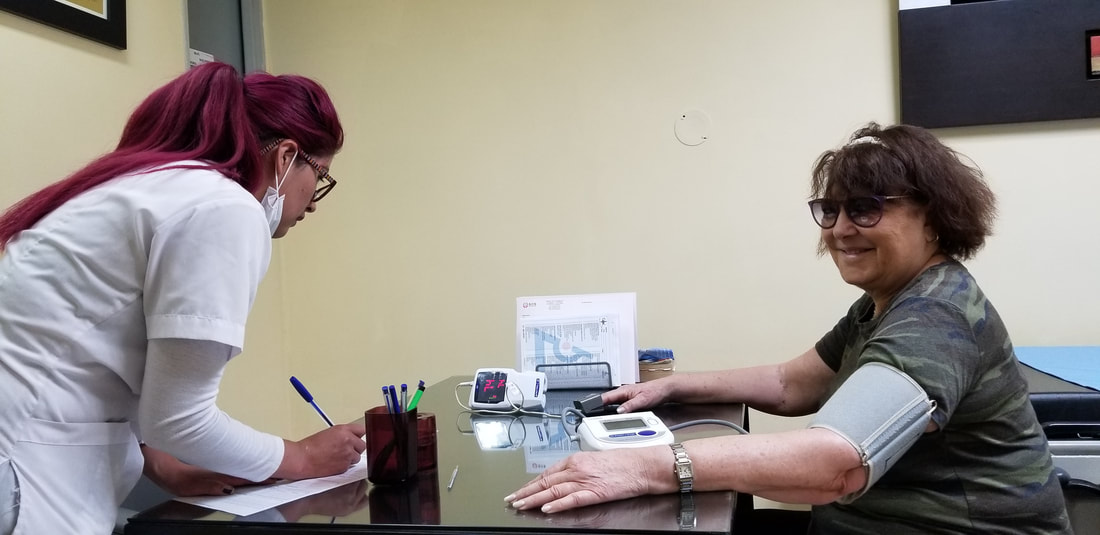 Miriam on her first day at the hospital. Thanks Miriam for being such a good sport about the whole situation! And, your feedback on the Medical Center SOS and the travel insurance company will make our program stronger! Miriam on her first day at the hospital. Thanks Miriam for being such a good sport about the whole situation! And, your feedback on the Medical Center SOS and the travel insurance company will make our program stronger! LESSONS LEARNED When I bring adults explorers and my field students down here, we will have to be very alert to the initial signs of oxygen deprivation. I'm going to be buying a digital finger oxygen meter to have down here just in case. One of the reasons I had Miriam come with me as my initial adult traveler was I knew she would give me good feedback on my program. And, her feedback on both the SOS Medical Center (which passed with A+ marks) and the travel insurance we purchased (which received a resounding FAIL) is invaluable! And, Miriam had a GREAT attitude throughout the whole ordeal...and even took the fact that she had to return home with a good attitude! Thanks Miriam for being such a good sport...we'll connect some other trip at a lower altitude! Luckily, my oxygen levels seem to stay around 88% to 95%. I'm wondering if there's any type of blood test to see if someone has a risk of being at altitude. I'll have to look into that. With today's DNA tests and other medical advancements, I bet there is some way to pre-screen people for altitude susceptibility. Maybe that little, tiny 1% of Andean DNA that I have is enabling my blood to uptake oxygen almost as effortlessly as the locals, whose actual blood cells are different than us lowlanders, enabling them to process oxygen very well at these high altitudes.  OTHER LOGISTICS On top of altitude, there are many different aspects of living in Peruvian culture that tend to throw us Americans for a bit of a loop. One of the aspects of traveling to another culture I love is appreciating these differences and learning to adjust. But, adjust we must. So, for those of you intending to come down here at some point, either as my adult explorers or as field students, here are some factors to take into consideration. ELECTRICITY This country runs on 220 power. We are used to 110 in the USA. Last time I was here, that meant I had to have converters for everything. And, power can be inconsistent, often surging high or cutting out altogether. So, this time I find that most outlets have now been fitted with the two round prong plugs that I'm used to seeing in Peru, but they also have the ability to fit our flat little two prong plugs. So, yes...you can plug into the outlets, but you run the risk of blowing up your equipment. So, do so with caution. My solution, I only plug in as along as I can monitor the charge...and as soon as the device is charged, I unplug. So far...no fried equipment...keeping my fingers crossed! And, watch out for the almost daily electrical storms...I try to unplug during these. 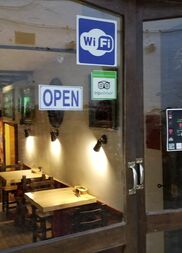 WIFI Wow, unlike the US, almost EVERY place here offers free WiFi...and it's usually pretty good speed. The downside of course, no security. So use with caution. I'm sitting right now at my favorite place to work, the Hotel Monesterio, and using their free WiFi...just don't doing any banking or anything else that requires security and a password. WiFi is also susceptible to the weather. I discovered this fact this morning as I was trying to upload a rather large file to a client of mine (yes, I am still working from Cusco for my Carmel/Monterey clients) and it just wouldn't go. I had to go down to a little Pizza place in Cusco to use their WiFi to get it uploaded.  SHOES Yes, the lowly "zapatos"...a very important part of your survival here. Why? Because the streets here are ancient. They are often wet. Stones are irregular, sharp, and it's VERY easy to twist an ankle, fall or worse. So, choosing your daily shoes is very important. Some of the local women can be seen wearing sturdy heals, but even for me (and those of you who know me know I love my heals) risking these types of shoes here is just not worth it. I brought two pairs of boots. One a low ankle boot and the other a higher boot for hiking. But, I also ended up buying a pair of slip on sneakers. This morning as I was headed out the door down a VERY steep staircase, I ended up taking off the sneakers and putting on my hiking boots. Why? It was raining and the task of navigating down the steep stairs required stability. Unlike these brave guys taking bookshelves down the stairway right outside my flat without a second thought...I go step by step like sure footed donkey. Fashion went out the door when I came down here.
There's a big difference between the "supermercado" and the local "San Pedro" market. Think of our Farmer's market with WAY more stuff. You walk into this huge place and are immediately overwhelmed by aisle and aisle of "not-plastic-wrapped", RAW goods. The meat aisle smells of blood. The fruit aisle is a feast for the eyes and nose, as is the artisan cheese section. Nothing is wrapped like us Americans are used to. And that can be jarring, interesting, and an education all at the same time. Not for the faint of heart and certainly not for vegans. Couple of other pointers when shopping. When you buy produce, it must be weighed and priced by the person in the produce department. They won't do it for you at the check out counter. And, just because it's in a package with plastic wrap doesn't mean it has a price. Milk comes in a box in the canned section of the store, not in the dairy case. Fruit is either HUGE or tiny. Limes are the same as lemons here...you won't find a yellow lemon. Many items come in a plastic squeeze box, like cream, mustard and mayo. Mexican food like tortillas don't live here. Coffee is great, but REALLY expensive. Finding garbanzo beans is something I have yet to accomplish. Olives are hard to find too, as are pickles. No where in town have I found a place that serves a burger with pickles...and given I like pickle burgers, this is a bummer. I swear I'm going to bring my own pickles in my purse along with my hand sanitizer and tissues. Salad stuff like we Californians like is hard to cobble together. You have to be careful buying lettuce and all produce needs to be washed VERY well. I usually soak things in the sink with a bit of dish soap before eating. So far, so good. If you like MEAT...this is your culture. For those of us who prefer chicken and veggies, work is required. Going into my third week here, I think I'm finally set.
Given the number of one-way streets and the fact that the Plaza de Armas shuts down to traffic frequently (at inconsistent hours), you can't rely on taxis being willing to take you where you want to go. If the driver thinks it's just too much of a hassle to take you where you want to go, they will refuse the ride. And, at night and when the streets are wet, getting up the hill to our flat on Calle Resbalosa has turned out to be a BIG feat! If you haven't already seen the video of us getting stuck one night while it was raining...check it out. Scary...funny...and very common! So, plan ahead for your taxi rides. And, you can always go to a big hotel and ask them to call you a cab...which will cost a bit more, but is worth it.  EXCHANGE RATE MAKES THE US DOLLAR GO FAR Right now, you get 3.34 Soles per US Dollar. Which makes Peru really a good deal for us Americans. You can get a 4 star meal at one of the great restaurants with a drink for about $35. Shopping for handmade crafts, clothing and jewelry is also fun given the exchange rate. And, of course, you are expected to bargain. I've been having fun collecting new pendants for my BeadItForwardStore website. And, if you buy now, I'll be sure to ship your purchase to you as soon as I get back on the 7th of February so you get your purse in time for Valentine's day. I'm having a blast finding unique beads and pendants from local artisans. And, as always, every purchase will come with a free pair of earrings that I'm finding here too! I've been having a blast taking pictures of my finds against the ancient backdrop of historical churches and megalithic stone structures. I'm looking forward to finding more unique, homemade items when I start working in the local communities on the Saqsaywaman site next week. Especially homespun woven goods and raw materials like alpaca yarn dyed with natural colors. Can't wait!  NEXT STEPS This coming week my fellow visual anthropologist, Dalton Gaudin, arrives to help me with my research up at the Saqsaywaman archaeological park. We will be working the the Ministry of Culture professionals as well as the various communities that live on the site. I've been trying to team up with Dalton for years and I'm so honored that he's willing to join me on this project. He totally understands what I'm trying to do and I look forward to including his insights on this amazing place in my next blog. He will bring a level of professionalism and his amazing skills as a cinematographer to this project. He also is planning to produce a book of photos from the research. Stay tuned if you are interested in purchasing his photographic story of Saqsaywaman. Check out his website at: DaltonGaudin.com Safe travels Dalton. Can't wait to see you! Thanks again to all who are reading this and supporting my work. As we get ready to go into the field next week, I am truly touched that so many people have believed in me!!!  Shaman carefully placing the ceremonial objects that will be given in honor to Pacha Mama. Shaman carefully placing the ceremonial objects that will be given in honor to Pacha Mama. Going into my second week here in Peru I find myself waiting, as I knew I would, for my "Convenio"...the permission paperwork I need to work on the Saqsaywaman archaeological park. I drafted a whole research proposal and it is being translated into Spanish at this moment. It will be submitted to the park management on Friday and then we will be doing a Pacha Mama ceremony there. Whenever you work on the land here in Peru, you honor the spirit of Pacha Mama by making an offering. I've done this each time I've been here and I'm hoping this time to be able to film this sacred ceremony. I will be working with a Shaman and the people at the Ministry of Culture. And, I'll have my friend/blogger Miriam Sieden with me as well as Fiorela from Maximo Nevel to help with the translations. More on this ceremony next blog. 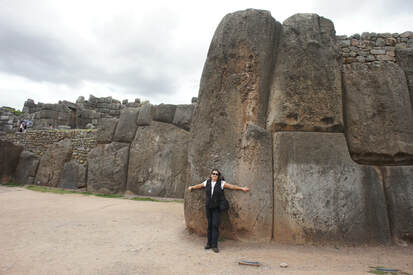 Maren against one of the largest of Saqsaywaman's megalithic stones. Maren against one of the largest of Saqsaywaman's megalithic stones. So, in the meantime, I've been visiting the various amazing ancient sites here in Q'osqo and engaging in my secondary research passion...ancient stone architecture. A little history on this aspect of my passion for Peru is needed. When I first arrived at Saqsaywaman in 2010, I knew the archaeological park was dedicated to the preservation of the main temple complex wall. And, I knew this wall was made of megalithic stones. But, what I didn't know then was that there really are several types of stones in various types of architecture here in Saqsaywaman and in the general Q'osqo area...and beyond. Thus, starting in 2010, I starting studying the ancient stone structures found here In Peru (Andes & coastal). When I immersed myself in this research, I also found that there are megalithic stone structures around the world that are similar to those here in Peru. Over the years since 2010, I've become fascinated with the documentation of these locations and am trying to understand what all these stone ambassadors from the past have to tell us about our human history on this planet as a whole. Stone Types In Q'osqo, Peru Let's start where I started, with the various stone structures here in Q'osqo and up the hill at the Saqsaywaman archaeological park. Everywhere you walk here in town and up in Saqsaywaman, if you look closely, you notice that some stones looks much more finished and perfectly fitted together than others. It doesn't take much of a walk to find examples of stone walls where the lower course (most often the oldest) is the most perfect in construction, whereas the stones on the top are often crude. This anomaly challenges our belief that human cultural progress, including architectural skills, should be at their peek now. But, what we find here in Peru is that the oldest structures are often the most perfect and the newer architecture, especially the contemporary work, is often crude and imperfect.  Maren sitting by a perfectly cut rock structure at Saqsaywaman, the purpose of which is still a source of research. Maren sitting by a perfectly cut rock structure at Saqsaywaman, the purpose of which is still a source of research. Controversy About The Stones There is quite a bit of controversy about the age of these stone artifacts, the way the stones were cut, moved, and placed in these massive walls and buildings. There are archaeological opinions. There are ancient alien theories. There are names for the types of stone work based on the type of rock, the design of the stone, the presence of a vitrified surface (that indicates some source of heat melted the surface)...there is NO lack of theories about these various stone buildings and walls and who made them. The one consistent factor is that there really isn't a definitive theory, that everyone can agree on, as to the history of these stone structures. The other consistent factor is that people who see these stones are almost always amazed at their construction and wonder "how did the ancient people who were supposed to have simple stone tools and copper chisels make these structures?" The diversity in the types of stones and perfectly cut structures (like the one Maren is sitting by) is mind blowing. Everywhere you go in Q'osqp and up at Saqsaywaman, you encounter stones that defy explanation and boggle the mind. For me...understanding the message these stones have for us is a pursuit that keeps me busy in my off time. I love finding a new documentary about these enigmatic stones around the world; the new academic paper by a peer; or coming across a new structure or stone I haven't seen before here in Peru.
 Samuel Kjuro Arenas with Maren Samuel Kjuro Arenas with Maren When I planned to come down to Q'osqo (Cusco), my hope was to meet with the new Director of the Parque de Archeological de Saqsaywaman by the second week and, hopefully, get an update and permission to work on the site again. I had no idea we would be welcomed so quickly and warmly as we were today! With the help of two of the heritage professionals we worked with before, Jose Antonio Reynoso & Samuel Kjuro Arenas, a meeting was schedule with the Director Francisco Solis Diaz for today, January 3rd. I had to quickly update my presentation and get ready in less than 24 hours for this important meeting. They were particularly interested in the fact that my recent DNA test showed that I have 1% Andean blood in me. The director said "I'll have 10% in me by the time I leave."  Jose Antonio Reynoso with Fiorela Romers (from Maximo Nivel) Jose Antonio Reynoso with Fiorela Romers (from Maximo Nivel) I was lucky to have one of the client services managers from Maximo Nivel, Fiorela Romero, assist to translate...and she did a GREAT job! The meeting started, much to my relief, with Jose Antonio and Samuel giving the director a recap of the work we had done before describing it as "valuable" and "impartial." Then, I gave a 30 minute PowerPoint presentation about the project and then we had a discussion about how we might be of assistance from this date forward. The head of park anthropological research, Miguel Silva, was also there and helped to clarify what the status of each community is currently. There are many new issues, mainly the expansion of Q'osqo into the park boundaries, as well as some other issues in new communities that we have not worked in before.  Top L to R, Mario Conejo Ortiz (site management), Miguel Silva (Archaeologist), Maren Elwood, Francisco Silva Dias (park director) & bottom Jose Antonio Reynoso (now working at another site, but one of our original contacts) Top L to R, Mario Conejo Ortiz (site management), Miguel Silva (Archaeologist), Maren Elwood, Francisco Silva Dias (park director) & bottom Jose Antonio Reynoso (now working at another site, but one of our original contacts) The new director, Francisco Solis Diaz, seems to have worked to calm some of the conflicts that existed on this site last time we were here. It seems that each community now has a representative that speaks to the Ministry and helps to iron out various issues. The director has direct relationships with a few of the communities and we will plan to interview him later in the month to document how he negotiated solutions to some of the conflicts that existed before. He feels that the communities of Pucara, Fortelaza & Wayllarqocha currently have good relationships with the Ministry. Whereas, there are a couple other locations that would benefit from our help to discover what the issues might need to be addressed. The map of the archaeological park has changed a bit since we were here last, so we will be getting a new master plan for the site so we can identify locations we can be helpful. One of the pressing problems the park has right now is encrochment from the city below, Q'osqo. Our next step is to put together a formal project proposal and submit it, in Spanish, to the office Matera Direccion Desconcentrada del Cultura de Q'osqo so we can be given a convenio...basically our permission to work on the site to do academic research. I will be working, hopefully with Fiorela Romero (from Maximo Nivel) to do this. I will have a meeting tomorrow with Marco Boyd, director of International Programs at Maximo Nivel, to see if we can retain the services of Fiorela as our project translator. Hope so...she did a great job today during a pretty technical meeting. 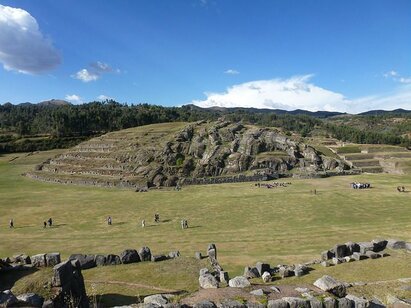 After the meeting we took a quick tour of the main Saqsaywaman complex. Mario Canajo spoke about the current thinking about the volcanic stone outcrop at the center of the complex. The most recent information is that the Inca believed this stone, which is obviously volcanic in nature, was believe to be the "Q'osqo"...navel of the Earth. The Inca believed this stone structure was sacred as it was the original mound that emerged to form the city. I'll have more about this aspect of Saqsaywaman, as well as the main wall complex in a later blog. This site consists of so many unique stone structures, both man made and natural that it's easy to understand why there's a desire to preserve the site for humanity.
As I get ready to travel to Peru this January, I thought it might be good to provide some historical context as to why I'm so interested in working in Peru. Many people have asked me. Some close to me know of my passion for Peru. However, few people know how far back my interest in the cultures of Peru reaches.
 Little Maya head with Conquest of Peru books. Little Maya head with Conquest of Peru books. As I recall, when I was in my early teens, I picked up a book entitled "The Conquest of Peru." In this book were photographs of the Inca people who had similar faces and headdresses. That realization that this amazing little head was probably of South American origin started my life-long pursuit of information about Peru and other native American cultures. Years later my mother and I went to Antiques Roadshow and I confirmed that the little head was indeed from native American origin. It turns out that it represents a Mayan king with his headdress from Meso America. Despite the fact that this little head turned out to come from the Mayan culture in the central part of the Americas, my interest in South America and the Peruvian culture was cemented in my soul.
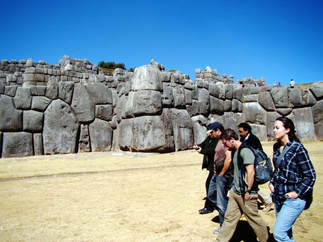 First trip to Saqsaywaman with small crew and Ministry of Culture professionals. First trip to Saqsaywaman with small crew and Ministry of Culture professionals. To finish my Masters program I had to design and conduct an ethnographic research project and then produce a film telling the story of the project to get my degree. This was the perfect opportunity to find a project in Peru that I could work on as a visual anthropologist. I searched around, with the help of the professionals at the Cotsen Institute at UCLA, and found a project at the archaeological site of Saqsaywaman just above Cusco, Peru. In 2011, I made my first trip to Peru to film what was supposed to be a stakeholder's meeting between the Ministry of Culture and the descendants of the Inca who lived on the active archaeological site. I was accompanied by Ben Younkman, the on camera researcher, and Becky Roth, the project administrator. Long story short, the meeting never happened because the situation between the stakeholders on the site was too tense. At first I thought this was bad luck, as I had flown us all down there and now didn't have a project to film. But, due to creative thinking by the Ministry of Culture professionals, they asked us to go up into the communities and film their grievances and then bring that film down to the Ministry as a way they could start fruitful conversations in a tense situation.
 Luis Gevara addresses a meeting of the Ministry of Culture professionals where our filming was presented and discussed. Luis Gevara addresses a meeting of the Ministry of Culture professionals where our filming was presented and discussed. The Ministry of Culture management staff has changed many times since I've been there last. Thus, this January we will be meeting with them to update them on who we are and finding out how best to work to accomplish their current goals and objectives. As always, our team MUST remain impartial so both sides will trust us to be truthful reporters of the situation to all sides. It's helpful this year that we are associated the the non-profit Global Purpose Group and have secured our own funding. Thanks again to everyone who has donated to our project. While in Peru this January, I will also be studying the local Spanish/Quecha dialect at the Maximo Nivel language school. And, I'll be working with this multi-national school to setup the plans for the field school that will start in January 2020.
And, one more point of interest, I recently had my DNA profile done and was pretty surprised to find that I'm 24% native American...with 1% of that being from PERU!!! I hope to find someone in Cusco who might be able to help me find a way to discover my Peruvian roots. Pretty amazing that I have Peruvian blood in me! If you've made it this far on this blog...I'm impressed! Thanks so much to all my friends and supporters. I've been touched through the years by the notes and cards people have sent me saying they believe in my vision for my project. Below are some of the cards and well wishes I've received over the years from people who have believed in me and my project in Peru Thanks so much to you all!! Stay tuned...I'll be posting a blog each week from Saqsaywaman. |
Author
Maren Elwood is a visual anthropologist and founder of On-Site Expeditions...a field school that will provide scholarships to aspiring heritage professionals. The first field school session will be in January 2020. Archives
September 2023
|
